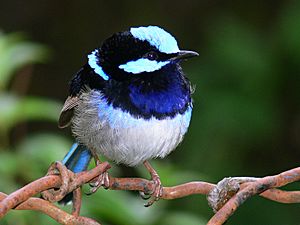Australasian wren facts for kids
Quick facts for kids Australasian wren |
|
|---|---|
 |
|
| Male superb fairywren (Malurus cyaneus, Maluridae) |
|
| Scientific classification |
|
| Kingdom: | Animalia |
| Phylum: | Chordata |
| Class: | Aves |
| Order: | Passeriformes |
| Superfamily: | Meliphagoidea |
| Family: | Maluridae Swainson, 1831 |
The Maluridae family is a group of small, insect-eating birds found only in Australia and New Guinea. These birds are often called 'wrens' because they look and act a lot like the true wrens found in Europe and America. However, they are not actually related!
This bird family includes 15 different kinds of fairywrens, 3 types of emu-wrens, and 11 kinds of grasswrens. There are six main groups, or genera, within the Maluridae family.
Contents
About the Maluridae Bird Family
The Maluridae birds are part of a large group of birds that evolved in Australasia. They are thought to have come from ancestors similar to crows. Their closest relatives are the honeyeaters (Meliphagidae) and the Pardalotidae birds.
Why Are They Called 'Wrens'?
Even though Maluridae birds are called 'wrens', they are not genetically related to the wrens you might find in the Northern Hemisphere. Their similar look and behavior are an example of convergent evolution. This means that different species, living in similar environments and having similar lifestyles, can develop similar traits over time, even if they are not closely related. They simply share the same "job" or "niche" in nature.
How Do Australasian Wrens Behave?
These birds have behaviors similar to many other perching bird families.
- Territory and Mating: Male Maluridae birds are known for defending their territory. They attract females with their songs and bright, colorful feathers.
- Appearance: Female birds are usually a dull brownish color. This helps them blend in with their surroundings, providing good camouflage. The males' bright colors become much less vibrant when it's not mating season.
- Diet: All Maluridae birds are insectivores, meaning they eat insects.
- Nesting: They typically build their nests in thick, dense bushes and plants.
The way they behave and their appearance have many striking similarities to the wrens found in Europe and Asia.
See also
 In Spanish: Malúridos para niños
In Spanish: Malúridos para niños

